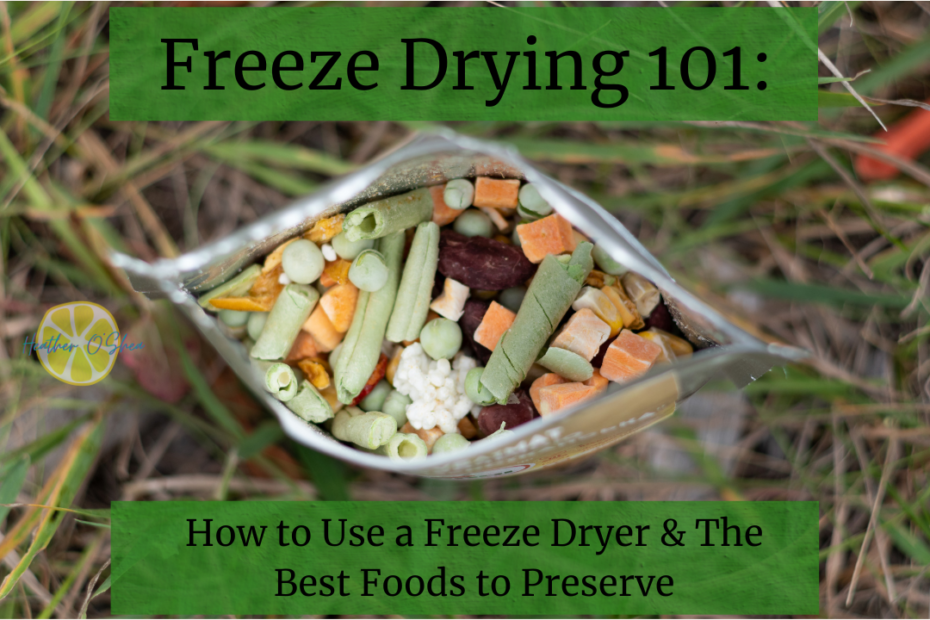*This post may contain affiliate links and I may earn a small commission when you click on the links at no additional cost to you. As an Amazon Affiliate I earn from qualifying purchases. You can read my full affiliate disclosure here.
If you’re looking to level up your food preservation game, a freeze dryer is a total game-changer. Unlike traditional dehydrating or canning, freeze drying keeps food fresh for up to 25 years while locking in nearly all the nutrients. Plus, when rehydrated, it retains its original taste and texture—pretty cool, right? Whether you’re prepping for emergencies, making lightweight camping meals, or just trying to cut down on food waste, learning how to use a freeze dryer is a skill worth mastering.
How Does Freeze Drying Work?
Freeze drying (a.k.a. lyophilization) removes moisture by first freezing food solid, then slowly warming it in a vacuum chamber. This process turns ice straight into vapor (skipping the liquid phase entirely), keeping the food’s structure intact while preventing spoilage. Basically, it’s science magic at work.
How to Use a Freeze Dryer
Using a freeze dryer might sound intimidating, but once you get the hang of it, it’s pretty much a set-it-and-forget-it process. Here’s a simple step-by-step breakdown:
1. Prep Your Food
- Cut food into uniform sizes to ensure even drying.
- Blanch veggies (like broccoli, asparagus, and green beans) to help them keep their color and texture.
- Pre-freeze high-moisture foods (like watermelon or yogurt) for better results.
- Lay food in a single layer on trays for even drying.
2. Load the Freeze Dryer
- Insert the trays into the freeze dryer.
- Double-check that the drain valve is closed before starting the machine.
3. Start the Cycle
- The machine will freeze food to around -40°F (-40°C) before starting the sublimation process.
- Expect the cycle to take anywhere from 24 to 48 hours, depending on the food.
- The machine will let you know when it’s done.
4. Check for Dryness
- Break open a piece—if it feels cool or soft inside, it needs more time.
- Run an extra drying cycle if needed.
5. Store It Right
- Mylar bags with oxygen absorbers = Best for long-term storage.
- Mason jars with desiccant packs = Great for short-term use.
- Vacuum-sealed bags = Perfect for keeping snacks fresh and crispy.
Best Foods to Freeze Dry
Now that you’ve got the basics down, let’s talk about the best foods to preserve, depending on your needs.
Emergency & Long-Term Food Storage
Stock up on these essentials for years of shelf life:
- Fruits & Veggies: Apples, bananas, strawberries, carrots, peas, bell peppers
- Protein Sources: Cooked chicken, beef, shrimp, scrambled eggs
- Dairy: Milk, cheese, yogurt drops
- Grains & Meals: Cooked rice, pasta, soups, stews, chili
Lightweight Backpacking & Camping Meals
Perfect for easy, lightweight meals on the go:
- Quick Meals: Beef stew, risotto, mac and cheese, scrambled eggs
- Snacks: Trail mix, granola, yogurt drops, fruit slices
- Protein Boosts: Freeze-dried chicken, beef crumbles, tofu
Healthy Snacks & Lunchbox Additions
Tasty, mess-free snacks for kids and adults alike:
- Fruits: Mango, pineapple, blueberries, raspberries
- Veggies: Zucchini chips, kale crisps, sweet potato slices
- Treats: Marshmallows, Skittles (yep, they puff up!), ice cream sandwiches
Pet Treats & Animal Feed
DIY pet treats that are healthy and long-lasting:
- Meats: Chicken, liver, fish
- Veggies: Green beans, pumpkin, carrots
- Eggs: Quail or chicken eggs for a protein-packed snack
Pro Tips for Freeze Drying Success
- Fatty foods don’t freeze dry well—avoid bacon and anything with too much oil.
- Label everything—you won’t remember what’s inside after a few months.
- Batch similar foods together—mixing foods with different moisture levels can extend drying times.
- Don’t overload the trays—it’ll cause uneven drying.
- Test rehydration before storing in bulk—some foods may need pre-treatment for the best results.
Final Thoughts
A freeze dryer is definitely an investment, but if you’re serious about food preservation, it’s totally worth it. Whether you’re prepping for emergencies, making backpacking meals, or just having fun with unique snacks, the possibilities are endless. Have a favorite food you’ve freeze-dried? Drop a comment below—I’d love to hear your experiences!
Want to get started? Check out Harvest Right Freeze Dryers for top-of-the-line home freeze drying equipment.
Happy freeze drying!
